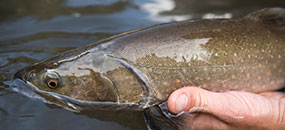March 30, 2006
Contact:
Chris Wood, TU Vice President for Conservation, (571) 274-0601
Ted Fitzgerald, TU American Fork Canyon Project Manager, (801) 465-9949
Chris Hunt, PLI Communications Director, (208) 552-0891 x 714
TU announces expansion of its abandoned mine cleanup efforts across the West
Conservation group asks Congress to enable ‘good Samaritan’ work and consider consistent funding
WASHINGTON—As Congress turned its attention to abandoned mine reclamation issues on Thursday by hearing testimony on the issue from all comers (see TU Vice President for Conservation Programs Chris Wood’s testimony by visiting www.tu.org), Trout Unlimited announced plans to expand its efforts to tackle abandoned mine recovery efforts across the West.
Using its successful effort to restore private lands on American Fork Creek in Utah’s American Fork Canyon as a springboard, the coldwater fisheries conservation organization is launching new abandoned mine cleanup projects in places like Colorado’s Snake River drainage and on Mores Creek in Idaho’s Boise River system.
Ted Fitzgerald, a former U.S. Forest Service engineer hired by TU to kickstart the organization’s American Fork work, said the blueprint established in Utah can work elsewhere. He pointed out the need for consistent federal funding and a straightforward permitting process that provides liability relief to “good Samaritan” organizations undertaking abandoned mine cleanups.
“We had all the elements come together in Utah, and this year we will be able to complete the cleanup and prevent the release of pollutants to a stretch of stream in a canyon that sees over a million visitors a year,” he said. Using federal money, a complex, one-time liability waiver from the EPA and help from private partnerships with the Tiffany & Co. Foundation and Snowbird Ski and Summer Resort, Fitzgerald will be able to remove heavy metal-laden piles of old mine debris and put them in a lined and sealed repository. Once that’s done, American Fork Creek will be better suited to contribute to the recovery of the increasingly rare Bonneville cutthroat trout. Also, he noted, American Fork Canyon will be a lot safer for visitors and the cleaner environment will benefit everyone downstream.
“It’s a great example of what can be done when the stars line up and everything works just right,” he said. “And now that we’ve done it once, we are ready to do it again in other places.”
A key ingredient to the success, of course, is the continued involvement of the private sector, particularly the funding from the Tiffany and Co. Foundation, which has pledged continued help to TU’s future abandoned mine work. Federal funding secured by Sen. Bennett (R-UT) also has provided essential support for the American Fork cleanup.
In Colorado, acidic and metal-laden runoff from the old Pennsylvania Mine on Peru Creek, a tributary to the Snake River in the Blue River system, has rendered Peru Creek a dead stream. Water quality in the Snake River itself it questionable.
TU hopes to join with a local task force already eyeing the project and use the American Fork work as an example to improve the conditions in Peru Creek and downstream in the Snake River.
“There’s a lot of promise there,” said Elizabeth Russell, Snake River watershed coordinator for TU. “The local community is in high gear and ready to get to work on this. With the same kind of help we got in Utah, we should be able to significantly improve the water, the fishery and the quality of life downstream from the Pennsylvania mine.”
In Idaho’s Mores Creek, a tributary to Lucky Peak Reservoir on the Boise River, the problems are a bit different, but the same collaborative process used in Utah will help TU and other local groups improve water quality and a struggling fishery that’s hanging on despite the impacts of mining along the stream years ago.
Mores Creek was dredge-mined in the mid-1900s, effectively disconnecting the stream channel from its natural floodplain. Piles of dredged materials along the stream prevent natural channel migration, and the lack of streamside vegetation allows the sun to beat down on the stream all day long. This has caused stream temperatures to rise significantly, hindering the native bull trout, redband trout and mountain whitefish populations.
“We’d like to reconnect the floodplain, create some meanders in the stream, and install some structure to improve fish habitat,” said Rob Roberts, western field coordinator for TU. Ideally, he said, the work would enhance the stream’s groundwater exchange, encourage streamside plant growth and help the creek stay cooler in the summer.
Restoring lands damaged by abandoned mines in Colorado and Idaho is just a small part of a huge cleanup effort that needs to be undertaken in the west. TU asked Congress to make abandoned mine cleanup efforts easier for concerned organizations and communities.
“Cleaning up abandoned mines might be the single-most, least-addressed environmental challenge in the nation,” said Brian O’Donnell, the director of TU’s public lands initiative. “The two greatest needs that we can identify for increasing the scope and scale of abandoned mine cleanup are the establishment of a dedicated funding source and the creation of a federal permitting process that encourages good Samaritan restoration projects. Lack of money and fear of liability are significant barriers to local restoration efforts.”
Trout Unlimited is the nation’s oldest and largest coldwater fisheries conservation organization. Today, TU boasts over 160,000 members nationwide.
-30-
Date: 3/30/2006



